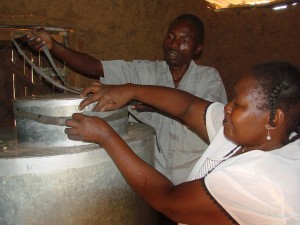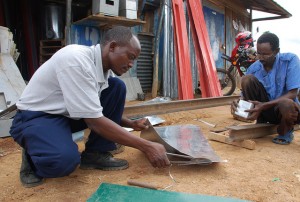
Who benefits from effective grain storage in eastern and southern Africa?
 Globally, about one-third of the food produced for human consumption is lost or wasted. In developed countries, much of that loss is the result of consumers throwing away millions of tons of edible food each year. But in the developing world, most loss occurs either in the field before a crop is harvested, during harvest and handling or afterwards in storage.
Globally, about one-third of the food produced for human consumption is lost or wasted. In developed countries, much of that loss is the result of consumers throwing away millions of tons of edible food each year. But in the developing world, most loss occurs either in the field before a crop is harvested, during harvest and handling or afterwards in storage.
In Eastern and Southern Africa, maize provides food and income to more than 300 million smallholder farmers in the region. After harvest, farmers typically remove maize grains from the cobs by hand, dry them in the sun and then store them in sacks kept in their home, in a shed or a traditional store. A considerable proportion of the crop may have already been lost in the field through pests and diseases. But once in storage, it is still vulnerable, particularly to insect pests such as the larger grain borer (Prostephanus truncatus) and maize weevil (Sitophilus zeamais). Some farmers are able to apply pesticides, such as actellic dust, to their stored grain but these are expensive and need to be reapplied every few months to be effective. Consequently, it is common for 20-30 percent of the region’s maize crop to be lost to storage pests each year. For families already living on the edge in terms of food security and income that loss represents a major problem.
Pest-proof storage
 The Effective Grain Storage Project[1] (EGSP) started in 2008 to introduce affordable and effective crop storage solutions for smallholder farmers. Led by Tadele Tefera, and working with local partners, the EGSP project is developing hermetic (airtight) technologies such as metal silos and super grain bags.
The Effective Grain Storage Project[1] (EGSP) started in 2008 to introduce affordable and effective crop storage solutions for smallholder farmers. Led by Tadele Tefera, and working with local partners, the EGSP project is developing hermetic (airtight) technologies such as metal silos and super grain bags.
Through the POSTCOSECHA program[2] in Central America, metal silos have been widely adopted in recent years. EGSP staff members have trained local African artisans to construct metal grain silos from 0.5 mm thick galvanized metal sheet. These small cylindrical drums, with a storage capacity of 90 kilograms (kg) to 1.8 tons (t), have soldered seams, making them airtight and impervious to pests such as weevils, larger grain borer and rats.
First piloted in Kenya and Malawi, the silos’ effectiveness has been tested alongside traditional and alternative modern storage methods and two African partner organizations were identified that were already working on crop storage – Catholic Relief Services in Kenya and World Vision International in Malawi.
Signs of success
By 2011, 150 silos of various sizes had been constructed in Kenya and Malawi. Many of these were bought by smallholder farmers, and others were ordered by schools and urban communities. Rose Owanda, a poultry farmer from Homa Bay – one of the Kenyan project sites – has bought six silos, each capable of storing 2.7 tons of grain. “I intend to buy grains from the market during times of glut,” she stated. “This will not only ensure that I buy grain at the lowest prices; I am assured of enough grain for making the feed for the birds throughout the year.”
Scaling up
A second phase of the EGSP was launched in 2012, focused on building capacity for improved technology development, testing, promotion, dissemination, policy and gender. By mid-July 2013, a total of 230 metal silos had been sold to farmers in HomaBay district alone. A further 47 had been bought by local institutions, mostly schools and colleges. This scaling-up of the project has been achieved by an awareness raising campaign, including demonstrations, videos and involvement of the local media, with much of this work carried out by national partners. MAIZE scientists, in collaboration with national partners, are carrying out on-station and on-farm trials that test the effectiveness of the improved grain storage technologies across different environments including in Zambia and Zimbabwe.
Despite the successes, however, the high initial cost of the silos is a significant challenge for widespread adoption. Costs vary, but in Kenya, a silo capable of holding 1.8 tons of grain (the most popular size) costs US$336. While the silos will last for over 10 years, making them much cheaper in the long run than conventional storage technologies, the initial outlay is prohibitive for many farmers unless they can obtain affordable credit.
According to economist Hugo De Groote, metal silos storing less than a ton are not cost- effective. As the average amount of maize stored per family is 500 kg, he argues that smaller farmers should be encouraged to consider other forms of hermetic tight storage, such as the super grain bag, which is capable of holding 90 kg of grain and is much cheaper than a metal silo. On the downside, the bags can be perforated by the larger grain borer and do not offer protection against rats.
To provide initial capital, De Groote recommends that credit facilities and collective action (e.g. loan associations) should be considered. One commercial bank has already shown interest. Significant scaling up, De Groote believes, will depend on the involvement of the private sector, as well as government. Meanwhile, policy economist Jones Govereh has called on governments to include galvanized metal sheets for silo construction under the tax exemptions in place for other agricultural imports.
Gender study
While in many places men control stored grain, women farmers have also benefited. Gladys Nthiga, a farmer in Embu County in eastern Kenya whose annual maize harvest averages 1.8 tons, has struggled to cope with storage pests. Therefore, she bought two silos with a capacity of 450 kg each. “Despite treating my grains with pesticides, I was still losing nearly half a ton of maize every year,” Nthiga said. “If what I have been told about the technology is true, then my problem with these pests is over,” she added.
In line with the SDC’s commitment to gender equality, EGSP seeks to benefit men, women and young farmers. In order to achieve these benefits, gender specialist Vongai Kandiwa is currently carrying out a gender analysis study in all EGSP countries that will lead to an evidence-based strategy for gender-responsive post-harvest research and technology dissemination.
The gender analysis will provide answers for crucial questions such as who loses and who benefits from improved technologies. Do the technologies meet the complex storage needs and preferences of men, women, and youth? How do the technologies reduce or exacerbate drudgery in post-harvest management? And in what ways do they change individuals’ access to and control over grain? In other words, while the economic benefits of improved technologies are encouraging, the EGSP team also seeks to foster other social outcomes such as gender equality in improved post-harvest technology access and adoption.
Ultimately, the goal of EGSP is to establish a well-functioning, sustainable silo production industry. In addressing the challenge of achieving food security for Africa’s expanding population, reducing the significant loss of grain to storage pests is a cost-effective strategy that deserves much greater recognition than it currently receives.
Africa, Kenya, metal silos, storage, super grain bags, training
